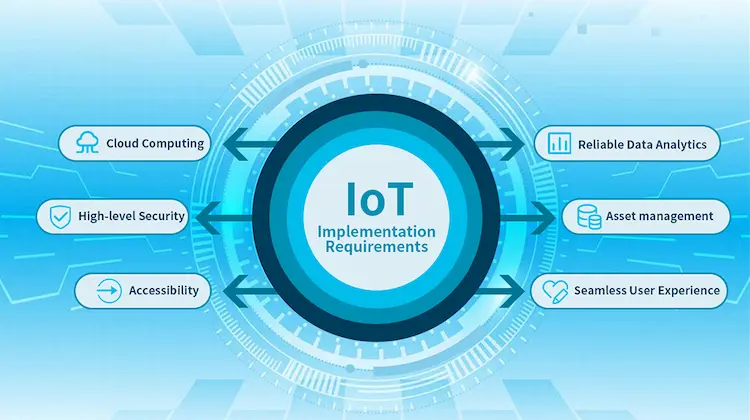The Internet of Things (IoT) has evolved from a buzzword to a foundational technology that is quietly revolutionizing how homes, businesses, and cities operate. IoT automation stands at the heart of this transformation, blending connected devices with smart, rules-based control to streamline tasks, reduce costs, and unlock new efficiencies.
Understanding IoT Automation
IoT automation refers to the use of internet-connected devices, sensors, and actuators to automatically monitor, control, and optimize processes or environments—without the need for constant human intervention.
How It Works
- Sensors and Devices: These collect data from the environment (temperature, motion, humidity, etc.) or machinery (production lines, vehicles, HVAC systems).
- Connectivity: Devices communicate via Wi-Fi, Bluetooth, Zigbee, LoRaWAN, or cellular networks—sending data to edge devices or the cloud.
- Automation Rules & Logic: Software applies logic such as “If X happens, then trigger Y” (e.g., if office occupancy is detected after 6 PM, turn off lights).
- Actuators/Controllers: Carry out the automated action—adjusting a thermostat, shutting a valve, sending alerts, or controlling machinery.
Key Benefits of IoT Automation
- Efficiency Gains: Automating repetitive tasks (like lighting, inventory tracking, or machinery maintenance) frees up human labor and reduces error.
- Energy Savings: Intelligent control of lighting, HVAC, and equipment reduces energy costs substantially.
- Predictive Maintenance: Sensors monitor asset health and trigger maintenance before breakdowns—cutting downtime by up to 50%.
- Data-Driven Decisions: Real-time analytics surface actionable insights for continual improvement.
- Scalability: Automation can be deployed across thousands of devices, facilities, or even cities, with centralized or decentralized control.
Major Applications of IoT Automation
1. Smart Homes
- Automated lighting, temperature, and security based on occupancy and time of day.
- Voice-controlled assistants triggering routines or alerts.
- Water leak detection and automatic shutoff.
2. Industrial Automation (“IIoT”)
- Predictive Maintenance: Manufacturing equipment schedules their own service or shutdowns based on sensor data.
- Asset Tracking: Real-time visibility into inventory, shipments, or mobile equipment movement.
- Process Optimization: Automated quality checks and adjustments in production lines.
3. Smart Buildings and Offices
- Lighting, climate, and security systems respond to occupancy and building usage.
- Automated booking of meeting rooms and desk spaces.
- Air quality and CO2 monitoring, with ventilation adjustments for occupant health.
4. Healthcare
- Remote patient monitoring with automated alerts for abnormal vital signs.
- Medication dispensing and reminder systems.
5. Transportation and Logistics
- Fleet management automation with route optimization and real-time vehicle health monitoring.
- Automated warehouse robots for order picking, packing, and inventory control.
Key Technologies Behind IoT Automation
- IoT Platforms: Cloud services (AWS IoT, Microsoft Azure IoT, Google Cloud IoT) aggregate data, manage devices, and enable automation workflows.
- Edge Computing: Processes data closer to the source for faster automation and reduced cloud dependency.
- AI & Machine Learning: Advanced analytics drive more autonomous, context-aware automation (e.g., energy prediction, security anomaly detection).
- Interoperability Standards: Open platforms and protocols (like MQTT, OPC-UA) enable diverse devices to work together seamlessly.
Real-World Example: IoT Automation in Action
A smart factory uses IoT automation to:
- Monitor conveyor motors for unusual vibrations.
- Automatically shut down a machine when a problem is detected and send a maintenance alert.
- Adjust production speed based on current order demand and machine health.
- Optimize power consumption by powering down idle equipment in real time.
Result: The factory increases productivity, slashes unplanned downtime, and cuts energy costs—all with minimal human oversight.
Challenges and Best Practices
- Security & Privacy: Large-scale IoT automation increases the attack surface for cyber threats. Encryption, regular updates, and network segmentation are critical.
- Integration with Legacy Systems: Adapting older equipment for IoT can require specialized gateways and careful planning.
- Data Overload: Implement smart analytics to sift signal from noise.
- Reliability: Use redundant communication paths and fail-safes for critical processes.
The Future of IoT Automation
By 2025, IoT automation is increasingly infused with artificial intelligence, enabling not just rule-based logic but dynamic, learning-driven decision-making. Next-generation systems will proactively predict needs and orchestrate coordinated actions across millions of devices—empowering both people and enterprises to do more with less.
In short: IoT automation transforms the connected world from reactive to proactive—making everyday environments smarter, safer, and vastly more efficient.
References:
- https://www.mckinsey.com/business-functions/operations/our-insights/the-internet-of-things-the-value-of-digitizing-the-physical-world
- https://www.gartner.com/en/information-technology/glossary/internet-of-things-iot
- https://www.ibm.com/topics/iot-automation
- https://www.csoonline.com/article/3242696/internet-of-things-security-guide.html



